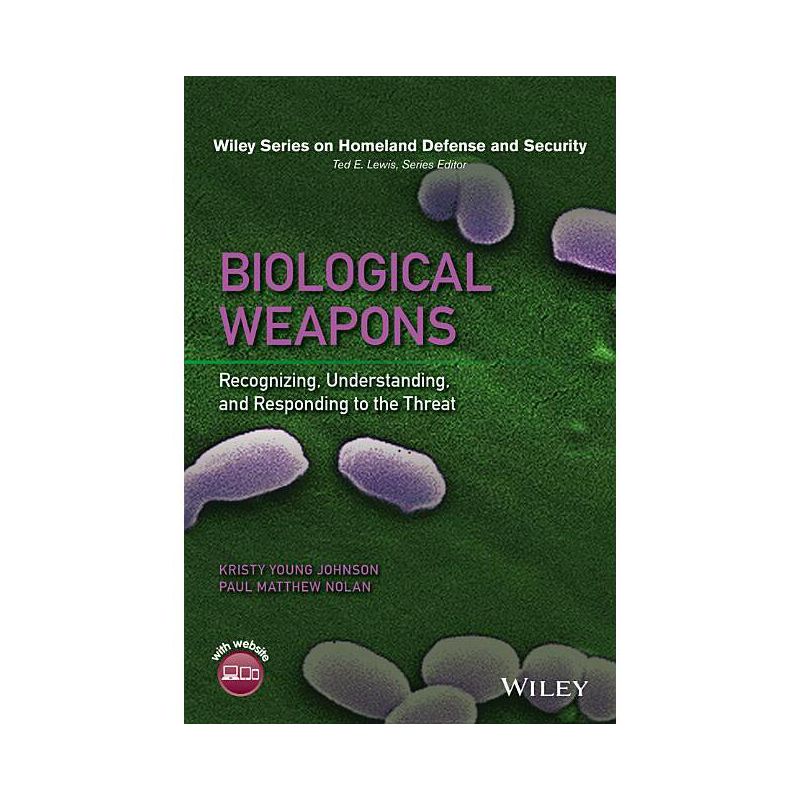Sponsored
Biological Weapons - (Wiley Homeland Defense and Security) by Kristy Young Johnson & Paul Matthew Nolan (Hardcover)
Sponsored
About this item
Highlights
- Gives readers a detailed understanding of how specific biological weapons work and how those affected by the weapons would be treated Teaches the reader to recognize the symptoms of each biological weapon and understand the threat these weapons pose Concentrates on the weapons considered the greatest threats by the CDC such as Anthrax, Botulism, Smallpox, Ricin toxin, Ebola, Plague, and Viral encephalitis Provides a detailed understanding of how specific biological weapons work and how to recognize the symptoms of those affected by the weapons as well as how they would be treated Includes case studies, chapter review questions, and the instructor's supplemental materials include PowerPoint presentations, a Test Bank, and suggestions for student projects Begins with a primer on microbiology, the human immune system's response to these biological agents, and the defense agencies involved with protecting the public against these agents
- About the Author: Kristy Young Johnson is an Associate Professor in the Department of Biology at The Citadel - The Military College of South Carolina.
- 360 Pages
- Political Science, Terrorism
- Series Name: Wiley Homeland Defense and Security
Description
Book Synopsis
Gives readers a detailed understanding of how specific biological weapons work and how those affected by the weapons would be treated
- Teaches the reader to recognize the symptoms of each biological weapon and understand the threat these weapons pose
- Concentrates on the weapons considered the greatest threats by the CDC such as Anthrax, Botulism, Smallpox, Ricin toxin, Ebola, Plague, and Viral encephalitis
- Provides a detailed understanding of how specific biological weapons work and how to recognize the symptoms of those affected by the weapons as well as how they would be treated
- Includes case studies, chapter review questions, and the instructor's supplemental materials include PowerPoint presentations, a Test Bank, and suggestions for student projects
- Begins with a primer on microbiology, the human immune system's response to these biological agents, and the defense agencies involved with protecting the public against these agents
From the Back Cover
Gives readers a detailed understanding of how specific biological weapons work and how those affected by the weapons would be treated
The subject of bioterrorism is only mentioned tangentially, if at all, in most undergraduate programs; however, biological weapons are a very real threat to all societies around the world. Some agents are available for legal purchase on the Internet with the proper credentials, and it is extremely likely that an international black market exists for the deadliest of these agents. Protocols for weaponizing some agents are available on the Internet, and most of the required materials can be purchasedat any large hardware store. Biological Weapons: Recognizing, Understanding, and Responding to the Threat is designed for anyone seeking knowledge on bioterrorism and biological weapons; one does not have to be a medical professional or even a science major to understand the discussions and terminology in this text.
The book is separated into four units and provides an overview of microbiology, the human immune system, agencies that monitor biological threats, and the major threats from bacteria, toxins, and viruses. The opening chapters include sufficient background for those unfamiliar with the subject matter. The Chapter Review Questions found at the end of each chapter provide a quick way to test understanding of the material, and the Unit Reviews help tie it all together.
Biological Weapons covers:
- Overviews of microbiology, immunology, and defense agencies
- Bacterial Weapons such as Anthrax, Plague, Tularemia, and Cholera
- Toxins including: Ricin, Botulism, and Staphylococcal enterotoxin B
- Viruses including: Ebola, Smallpox, Hantavirus, Viral encephalitis, Nipah Virus, Lassa Fever
- A closing chapter looking ahead at Policies, Procedures, & Prevention
The material presented here will increase the general knowledge of biological warfare agents and the dangers they present. The more aware we are of the threat, the more prepared our society will be to respond to an act of biological terrorism.
About the Author
Kristy Young Johnson is an Associate Professor in the Department of Biology at The Citadel - The Military College of South Carolina. She has taught a wide variety of undergraduate and graduate biology courses, including General Biology, Genetics, Microbiology, and Descriptive Histology. She developed an entirely new Bioterrorism course that she has taught regularly since 2007. She holds a Bachelor of Science in Chemistry from Gardner-Webb University in North Carolina and a doctorate in Pathology and Laboratory Medicine from the Medical University of South Carolina.Paul Matthew Nolan is an Associate Professor of Biology, Behavior, and Disease Ecology at The Citadel - The Military College of South Carolina as well as an adjunct professor in the Graduate Program in Marine Biology, and Graduate Program in Environmental Studies at The College of Charleston. In 2012 he was awarded the Faculty Spotlight Award for Excellence in Teaching and Scholarship from The Citadel. He has published extensively on the influence of condition and parasites on individual condition in a wide variety of bird species.
Additional product information and recommendations
Sponsored
